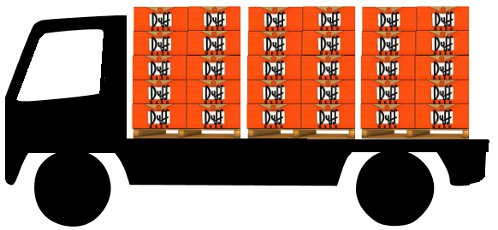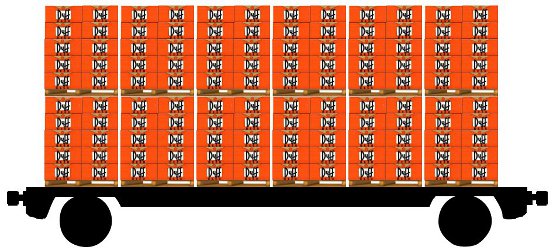The telephone industry is full of confusing terminology, much of which isn't used anywhere else and some of which seems intended to leave outsiders scratching their heads. For example, instead of calling the two wires making up your analog phone line 'positive' and 'negative' like anyplace else in the communications world they are called 'tip' and 'ring' respectively... because once upon a time they were connected with the tip and outside ring of a telephone operator's plug board.
Digital circuits, their inter-relationships and sizes is another common source of confusion. In the telephone industry most people are familiar with the "Beer Analogy" but I was surprised that I wasn't able to find it on the web while training a new team member - this page is an attempt to rectify that travesty.
For historical reasons the numbers below all apply to circuits and technology used in North America and Japan. Most of the rest of the world uses technology and circuits that are similar but the bandwidth and exact standards are different.
A Digital Signal 0 (DS0) is the smallest capacity digital circuit; depending on the technology used they provide either 56Kbps or 64Kbps. Analog modems that were once common for people's home Internet connections were sometimes marketed as 56K modems, but various limitations almost always kept the actual throughput below that level. At one time leased DS0 56K digital circuits were quite common in the business world but lower speed links like this have largely been replaced by VPN connections these days.
DS0 = 64 Kbps = 1 voice/data phone line.
Think of a DS0 as one can of beer.

A DS1 contains 24 DS0 circuits bundled together, and is often
called a T1 if it is being carried on copper wire via
T-carrier
systems.
DS1 = 1.544 Mbps, actually 1.536 Mbps + framing/control bits.
Think of a DS1 as a case of beer that contains 24 individual cans.

A DS3 is made up of 28 DS1 circuits bundled together, and is often
called a T3 if its being carried on copper wire. A DS3 contains
672 DS0s, and each one can have unique circuit IDs for billing and
troubleshooting purposes. Note that there is a DS2 standard but
it has never been deployed. In the telecommunications world this is
often the basic unit of measurement as DS0 and DS1 links are
aggregated together for transport and then split back out at
the remote end.
DS3 = 44.736 Mbps = 28/DS1 = 672/DS0
Think of a DS3 as a pallet of beer with 28 individual cases,
each still containing 24 cans.

At this point we've reached the upper limit of what can be carried on copper wires with common T-carrier systems so we make the leap to optical fiber connections, often on SONET systems. In that case at this point technically DS3 circuits are wrapped inside of OC1 (optical carrier 1) circuits, but we'll mostly ignore this detail for our analogy. You might think of the pallet of beer (DS3) being shrink-wrapped together for easy handling.
Just like the DS2 standard isn't actually deployed in the real world there isn't hardware deployed at the OC1 speed level. We telecom people do often talk to each other about needing a link with a given number of "STS" connections, an STS-1 is just an OC1 in electrical form - as it exists in our switches before being put onto the fibers.
The next largest widely deployed circuit is the OC3 link
(optical carrier 3) which can contain three DS3 circuits (inside their
OC1 shrink wrap) bundled together.
OC3 = 155.52 Mbps = 3/DS3 = 84/DS1 = 2016/DS0
You can think of an OC3 like a beer truck that can hold 3 pallets
of beer for a total of 2016 DS0 circuits.

The next commonly used circuit is the OC12, its made up of 12 OC1/DS3
circuits bundled together for a total of 8064 cans of beer.
OC12 = 622.08 Mbps = 12/DS3 = 336/DS1 = 8064/DS0
Think of an OC12 as a railroad train car that can hold 12 pallets
of beer.

The next commonly used circuit is the OC48, which is made up of 48 DS3
circuits. These circuits have a nice combination of reasonable hardware
prices and bandwidth which makes them popular choices for many regional
networks - often several can be deployed in parallel when bandwidth needs
haven't reached the level requiring investments in OC192 or 10 gigabit
Ethernet transport.
OC48 = 2488.32 Mbps = 4/OC12 = 48/DS3 = 1344/DS1 = 32,256/DS0
Think of an OC48 as a train with 4 railroad train cars each holding
12 pallets of beer, for a total of 32,256 beer cans.

In recent years OC192 circuits have become widely deployed as bandwidth
needs have grown and hardware prices have come down. The analogy we've
used still applies - more train cars are simply passing us each second.
In cases where the underlying traffic is entirely Ethernet many carriers
have often skipped this level to reduce expense and complexity, instead deploying
10 gigabit Ethernet directly using long-range optics or
DWDM systems.
OC192 = 9953.28 Mbps = 16/OC12 = 192/DS3 = 5376/DS1 = 192,024/DS0
Think of an OC192 as a train with 16 railroad train cards.

In cases where larger amounts of bandwidth are needed carriers
have began to deploy OC768 circuits, especially where fiber
channel capacity is limited. By our analogy an OC768 circuit
would have 64 of our OC12-sized railcars passing us each second.
OC768 = 39813.12 Mbps = 64/OC12 = 768/DS3 = 21,504/DS1 = 516,096/DS0
Think of an OC768 as a train with 64 railroad train cards.
